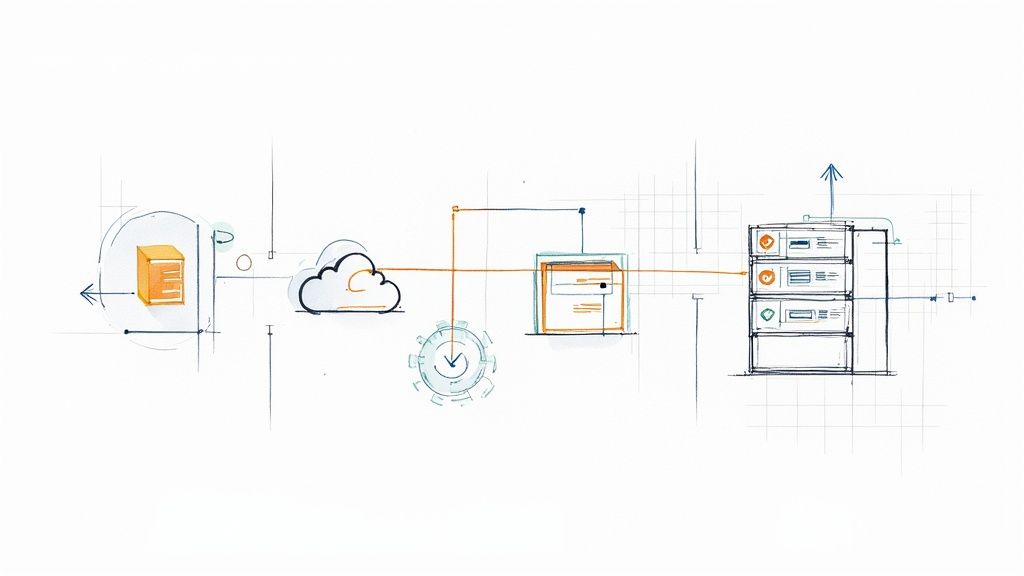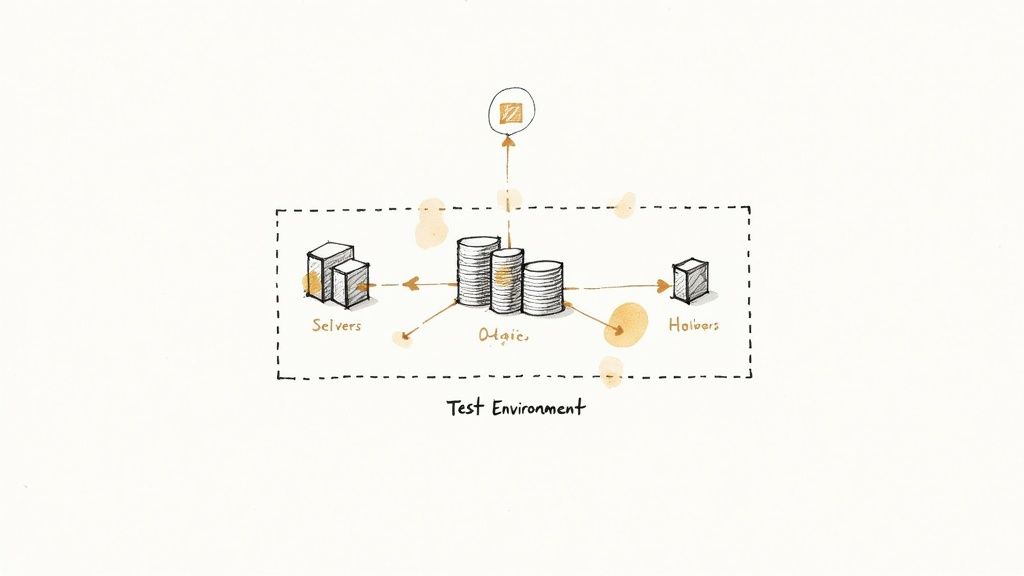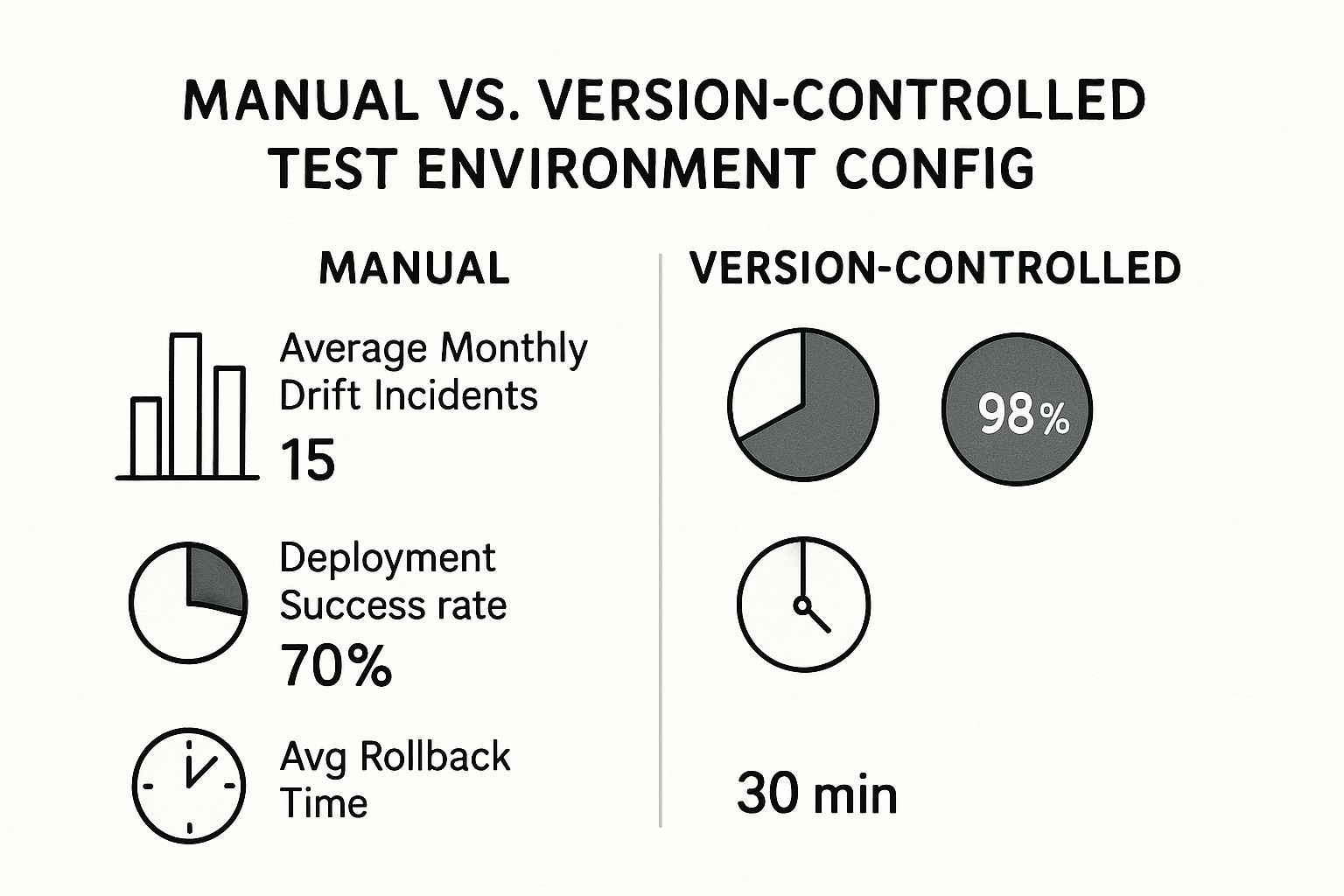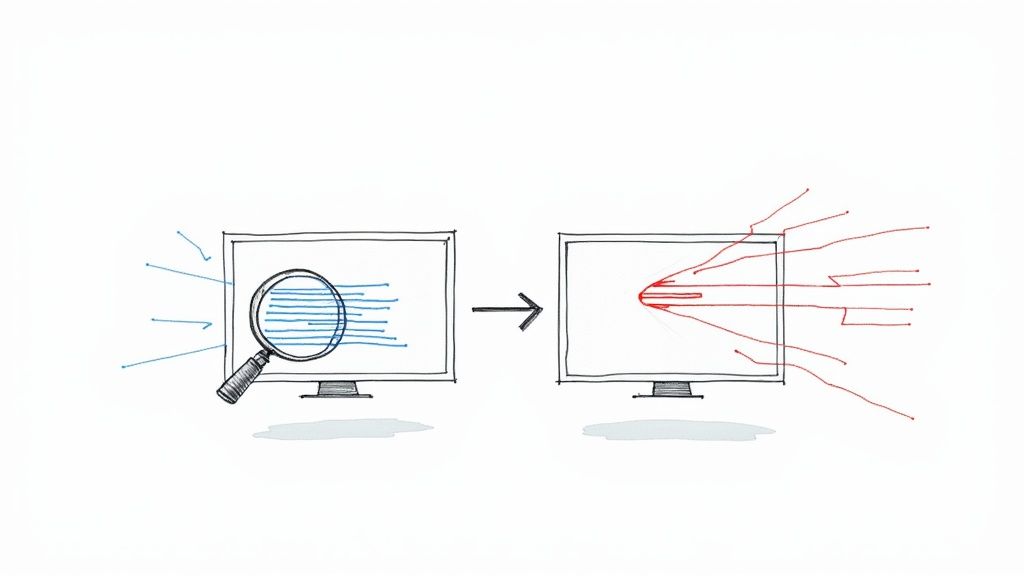Managing Test Environments: Your Complete Success Playbook

Building The Foundation For Test Environment Success

Effective test environment management is crucial for successful software development. It's not simply about setting up servers; it's about building a robust system that supports rapid development without compromising quality. This involves establishing clear processes, promoting teamwork, and using the right tools. Many teams, however, face challenges like environment conflicts, resource limitations, and inconsistent standards. These problems can cause significant delays, higher costs, and ultimately, lower software quality.
Defining Clear Roles and Responsibilities
A solid foundation starts with clearly defined roles and responsibilities for managing test environments. This ensures accountability and simplifies communication. For instance, assigning ownership of specific environments, specifying who provides resources, and outlining approval workflows can prevent conflicts and delays. This structure is essential for maintaining order and efficiency.
Effective collaboration is also key for any team. For tips on managing remote teams, check out these strategies: How to Manage a Remote Sales Team.
Planning and Resource Allocation
Effective resource planning is another critical element. This involves predicting the resources needed for each testing phase, budgeting appropriately, and setting up a system for requesting and approving resources. Just as a building project needs blueprints, test environment management needs careful planning to avoid resource conflicts and ensure smooth execution.
This proactive approach minimizes disruptions and keeps projects on schedule. It also allows teams to adapt to evolving project needs.
Implementing Standardized Processes
Standardized processes throughout the software development lifecycle are key to minimizing errors and maximizing efficiency. This includes clear procedures for environment setup, configuration, and teardown. Like a factory assembly line, consistent processes ensure each product meets the same high standards.
Similarly, standardized processes for test environments promote consistency and reliability across different testing stages. This is especially important in complex environments with multiple teams working on different features concurrently.
The trend towards more effective testing is clear. The State of Testing report for 2025 shows increased focus on test effectiveness, with 25% of teams now measuring it, compared to 19% in 2024. This reflects an industry-wide push to improve quality assurance through comprehensive coverage, better defect identification, and smarter testing methods. More detailed statistics can be found here. This commitment to standardized processes leads to higher quality and predictability in the final product. By incorporating these foundational elements, teams can build a robust and efficient system for managing test environments, paving the way for successful software development.
Streamlining Environment Setup Without The Headaches

Setting up test environments can be a major pain point for development teams. It often feels like a recurring nightmare, consuming valuable time and resources. However, leading development teams are adopting new strategies to make this process significantly more efficient.
Containerization: Ensuring Consistent Test Environments
These strategies often involve technologies like containerization and Infrastructure-as-Code (IaC). Containerization technologies, such as Docker, package applications and their dependencies into isolated units called containers. This ensures a consistent environment across different machines and operating systems, eliminating the dreaded "it works on my machine" scenario.
This portability also simplifies sharing environments among team members. A developer can create a containerized test environment, share it with a tester, and be confident that the tester has the same setup. This consistency leads to more reliable and predictable test results.
Infrastructure as Code: Automating Your Infrastructure
IaC takes automation to the next level. With IaC, you define your entire environment infrastructure – servers, networks, databases – in code. This code can then be used to automatically provision and configure your environments, drastically reducing manual configuration and the errors that come with it.
Furthermore, IaC allows for version control of your environment configuration. This enables tracking changes, reverting to previous states, and facilitating better collaboration on environment setup and maintenance.
Version Control and Automation: The Foundation of Efficiency
Version control and automated provisioning are critical for efficiently managing test environments. Just like with application code, version control for infrastructure allows for tracking changes and easy rollback capabilities. It also significantly improves collaboration among team members.
Automated provisioning, typically powered by IaC, removes manual steps and ensures consistent and repeatable environment creation. This combination reduces setup time dramatically, freeing up valuable developer time for other tasks. This can often mean the difference between hours and minutes for environment setup.
Smart Resource Allocation: Optimize Your Spending
Efficient test environment management also involves smart resource allocation. Over-provisioning can result in unnecessary costs, while under-provisioning can lead to performance bottlenecks that slow down testing.
Analyzing resource utilization patterns and implementing strategies like on-demand provisioning can help optimize spending. This often includes leveraging cloud solutions that allow scaling resources up or down as needed, so you only pay for what you use.
You might be interested in: How To Master Code Reviews. Efficient code review practices contribute to a smoother testing process by catching potential issues early.
Addressing Common Pitfalls in Environment Setup
Many environment setup projects encounter common pitfalls. These include inadequate documentation, inconsistent configurations across environments, and a lack of communication between development and operations teams.
Implementing standardized documentation practices, using configuration management tools, and fostering open communication are essential for success. Addressing these issues improves efficiency and reduces costly rework, leading to a more reliable and manageable test environment strategy. By adopting these strategies, teams can transform their test environment setup from a source of frustration to a powerful enabler of rapid and reliable software delivery.
Leveraging Cloud Solutions For Maximum Flexibility
Cloud-based testing environments are changing how development teams manage testing. Test Environment as a Service (TEaaS) offers solutions to real-world problems, including elastic scaling and reduced maintenance. This shift allows for dynamic resource allocation, adapting to the changing needs of projects. This flexibility is a major advantage over traditional on-premise solutions, which often require large upfront investments and ongoing maintenance.
Exploring Cloud Deployment Models
Organizations should consider different cloud deployment models. These generally include public cloud, private cloud, and hybrid cloud solutions. Each option has different benefits and drawbacks regarding cost, security, and control. Public cloud solutions offer scalability and cost-effectiveness, while private clouds focus on security and compliance. Hybrid approaches combine elements of both, allowing organizations to use the strengths of each model. Choosing the right model depends on the specific business needs and risk tolerance.
To better visualize the advantages of modern environment management, consider the comparison below:

As the infographic shows, version-controlled environments greatly reduce drift incidents, boost deployment success, and minimize rollback times. This data highlights the benefits of version control for managing test environments.
Let's take a closer look at the core differences between cloud and on-premise solutions, as well as the potential of a hybrid approach, in the following table:
Cloud vs On-Premise Test Environment Comparison: A comprehensive comparison of cloud-based and on-premise test environment solutions covering cost, scalability, maintenance, and security aspects.
| Feature | Cloud-Based | On-Premise | Hybrid Approach |
|---|---|---|---|
| Cost | Pay-as-you-go, potentially lower upfront costs | High upfront investment in hardware | Variable, depends on the balance between cloud and on-premise |
| Scalability | Easily scalable on demand | Limited by hardware capacity, scaling requires significant investment | Scalable through cloud resources, on-premise provides a stable base |
| Maintenance | Managed by the provider | Requires dedicated IT staff | Shared responsibility, reduced on-premise maintenance |
| Security | Shared responsibility, relies on provider's security measures | Full control over security, but requires internal expertise | Combines both cloud and on-premise security considerations |
| Control | Less direct control over infrastructure | Full control over infrastructure | Balance of control, depending on configuration |
| Accessibility | Accessible from anywhere with internet connection | Access limited to on-premise network | Accessible based on resource location (cloud or on-premise) |
This table summarizes the key differences between cloud, on-premise, and hybrid test environments, helping organizations choose the best fit for their specific needs.
Key Criteria for Vendor Selection
Choosing the right TEaaS vendor is essential for success. Key criteria should include factors such as security, compliance, integration capabilities, and cost. The vendor's reputation and customer support are also important. Getting feedback from other teams using TEaaS can be valuable. This research helps in making informed decisions aligned with long-term goals.
The Advantages of Cloud-Based Test Environments
Teams using cloud-based environments report significant advantages. These include increased agility, faster deployments, and lower infrastructure costs. The ability to quickly provision and de-provision environments allows for more flexibility and responsiveness. This responsiveness is vital in fast-paced development. The global TEaaS market is growing, reaching USD 15.2 billion by 2024 and projected to reach USD 62.0 billion by 2033, with a 16.06% CAGR from 2025-2033. More detailed statistics are available from IMARC Group. This growth highlights the increasing adoption and value of TEaaS.
Practical Considerations and Hybrid Approaches
Moving to the cloud requires careful planning and execution. Addressing security, compliance, and data migration is crucial for a seamless transition. Hybrid approaches, combining on-premise and cloud solutions, can provide a bridge during migration. This lets organizations gradually move to the cloud while minimizing disruption. By understanding these practical considerations, teams can use cloud solutions effectively for maximum flexibility.
Integrating With DevOps For Seamless Delivery

Test environments are crucial for successful DevOps practices. They shouldn't be an afterthought, but rather an integral part of the development process. By integrating test environment management directly into your continuous delivery workflows, you ensure that environment provisioning keeps pace with development.
This close integration allows for faster feedback loops, reducing the time it takes to deploy changes to production. Ultimately, this contributes to a more efficient and agile development process.
Automating Environment Orchestration Within CI/CD
High-performing teams often integrate environment orchestration directly into their CI/CD pipelines. This involves automating the entire process: provisioning, configuring, and deploying test environments as part of the build and release process.
For example, when a developer commits code, the CI/CD pipeline might automatically create a new test environment. It would then deploy the latest build, run automated tests, and finally, dismantle the environment once testing is complete. This automation saves significant time and minimizes the risk of human error.
Managing Dependencies Across Development Stages
Managing dependencies across different development stages is crucial. This means ensuring consistent configurations across development, testing, staging, and production environments.
Tools like containerization (Docker) and configuration management systems (Ansible) help track and manage these dependencies effectively. This consistency helps avoid unexpected issues when promoting code between environments.
Automation Strategies for Eliminating Bottlenecks
Automation is the key to removing manual bottlenecks in test environment management. By automating tasks like environment provisioning, configuration, and teardown, teams free up valuable time and resources.
This also reduces the chance of human error and improves the speed and reliability of the testing process. Automation promotes repeatability and consistency, addressing the infamous "works on my machine" problem.
Check out our guide on Continuous Integration Best Practices for more information on streamlining your CI/CD processes.
Collaborative Practices Between Development and Operations
Bridging the gap between development and operations teams is paramount for smooth environment management. This requires collaborative practices, such as shared ownership of environments, consistent communication, and joint problem-solving.
For instance, clear communication channels and shared dashboards can enhance visibility and collaboration. Shared responsibility leads to quicker issue resolution and a more harmonious workflow.
Maintaining Environment Consistency During Frequent Deployments
Maintaining consistent environments alongside frequent deployments can be challenging. However, techniques like infrastructure as code and configuration management help teams provision and configure environments reliably and repeatably.
Automated testing and monitoring can identify and address any inconsistencies. This focus on consistency ensures testing accurately reflects the production environment.
Furthermore, the increasing complexity of software development is fueling the test environment as a service market. It's projected to grow from $14.32 billion in 2024 to $17.19 billion in 2025, a 20.0% CAGR. Learn more about this growth here. This growth highlights the increasing importance of efficient test environment management in modern software development. By adopting these strategies, organizations can seamlessly integrate test environments into their DevOps pipeline, leading to faster delivery cycles and higher-quality software.
Monitoring And Optimization That Actually Works
Managing test environments isn't a set-it-and-forget-it task. It demands ongoing monitoring and optimization to ensure smooth operation. Think of it like maintaining a car – regular tune-ups are essential for optimal performance. Similarly, your test environments need consistent attention to prevent problems and maintain peak efficiency. This means implementing robust monitoring strategies and focusing on the metrics that truly matter.
Key Metrics for Monitoring Test Environment Health
Monitoring gives you vital insights into the health and performance of your test environments. But which metrics should you track? Key indicators include environment availability, resource utilization (CPU, memory, disk space), and test execution time. These metrics paint a clear picture of environment stability and performance, enabling you to proactively address potential issues.
For example, consistently high CPU utilization could signal a resource bottleneck requiring attention. Likewise, long test execution times may indicate inefficiencies in the testing process itself.
To help you get started, we've compiled a table of essential metrics for effective monitoring:
To help you establish a comprehensive monitoring strategy, the following table outlines essential performance metrics, their target values, and recommended monitoring tools:
Key Test Environment Performance Metrics Essential metrics for monitoring and optimizing test environment performance, including availability, resource utilization, and cost efficiency indicators
| Metric Category | Key Indicators | Target Values | Monitoring Tools |
|---|---|---|---|
| Availability | Uptime, Downtime | >99% uptime | Datadog, Splunk |
| Resource Utilization | CPU usage, Memory usage, Disk I/O | Within defined thresholds based on environment specifications | New Relic, Dynatrace |
| Test Execution Time | Time taken to execute test suites, individual test cases | Optimized for efficiency, consistent across builds | Jenkins, GitLab CI |
| Error Rates | Frequency of test failures, types of errors | Minimize errors, track trends over time | Jira, Bugzilla |
This table provides a foundational framework for monitoring and optimizing your test environment's performance. By tracking these key indicators, you can gain valuable insights into areas for improvement and ensure the stability and efficiency of your testing processes. Streamlining processes can include connecting your brokerage accounts to investment platforms, as discussed in this article: Integrating Your Commsec Trading Account With Navexa.
Automating Maintenance and Escalation Procedures
With monitoring in place, establish automated maintenance routines and clear escalation procedures. Regular maintenance, such as automated cleanup of old test data and system updates, prevents performance degradation and security vulnerabilities. Just as regular oil changes keep a car running smoothly, routine maintenance is crucial for your test environments.
Also, define clear escalation paths for when problems arise. This involves specifying who is notified when a critical metric deviates from acceptable ranges and outlining the steps for resolution. A well-defined escalation process minimizes downtime and prevents small issues from becoming major headaches.
Capacity Planning for Future Growth
As your team and projects expand, so too will the demands on your test environments. This requires proactive capacity planning. Regularly evaluate your current resource usage and project future needs. For example, if your team plans to increase deployment frequency, ensure your test environments can handle the added load. Much like urban planning accommodates growth, your test environments must scale to meet future demands.
This proactive approach prevents performance bottlenecks and maintains testing velocity as your organization grows.
Practical Optimization Strategies From High-Performing Teams
High-performing teams often employ additional optimization techniques, such as performance testing to identify and address bottlenecks early and cost optimization strategies to efficiently manage cloud resource expenses. Performance testing helps pinpoint specific areas for improvement, while cost optimization strategies ensure responsible resource spending.
Maintaining comprehensive documentation is also essential. This documentation should include environment configurations, troubleshooting steps, and support contact information. This allows for swift problem-solving when issues arise. Learn more about improving your testing process with our guide on How to Master Automated Testing Best Practices. By combining effective monitoring, automated maintenance, and proactive capacity planning, you can ensure your test environments remain a valuable asset, supporting development efforts and contributing to high-quality software delivery.
Solving Team Conflicts and Building Collaboration
Managing test environments isn't simply about the technical details. It's also about the people involved. Conflicts over resources, miscommunication, and unclear responsibilities can significantly hinder testing, slowing down the entire development lifecycle. This section explores how to address these challenges and foster a collaborative environment.
Common Challenges in Test Environment Management
Several common challenges can lead to team conflicts:
- Resource Contention: Multiple teams often need the same limited resources, like specific hardware or software. This competition can cause delays and frustration.
- Communication Breakdowns: A lack of clear communication between development and testing teams can lead to misunderstandings, duplicated work, and wasted time.
- Unclear Responsibilities: When roles and ownership aren't clearly defined, it's difficult to address issues quickly. This often leads to finger-pointing and stalled progress.
- Conflicting Priorities: Different teams may have different priorities regarding test environments, making it hard to coordinate testing effectively.
These challenges can significantly impact the efficiency and effectiveness of your testing process.
Strategies for Effective Collaboration
Successful organizations use several strategies to prevent and resolve team conflicts related to test environments:
- Environment Booking Systems: A booking system lets teams reserve specific environments for set times, reducing resource contention and ensuring access when needed.
- Clear Usage Policies: Establishing clear usage policies and guidelines for each environment helps prevent conflicts by setting expectations and establishing shared responsibility. Think of it like ground rules for a shared workspace.
- Dedicated Communication Channels: Dedicated channels, like Slack channels or shared email lists, promote timely and transparent communication, minimizing misunderstandings.
- Regular Team Meetings: Regular meetings, even short stand-ups, offer a forum to discuss upcoming testing, address any conflicts or dependencies, and facilitate collaborative planning.
These strategies create a structured and collaborative environment that fosters shared responsibility.
Managing Complex Dependencies and Multi-Team Testing
Coordinating testing in complex projects involving multiple teams can be a major undertaking. Practical techniques include:
- Dependency Mapping: Visualizing dependencies between teams and their testing activities can help identify potential conflicts early on, allowing for proactive solutions.
- Cross-Team Collaboration Tools: Collaborative project management tools like Jira or Trello enable teams to track progress, share information, and communicate effectively.
- Centralized Environment Management: A centralized platform for managing test environments provides a single source of truth for environment status, configurations, and usage schedules, improving transparency and coordination.
Building a Culture of Shared Responsibility
Effective test environment management requires a culture of shared responsibility. This involves:
- Promoting Open Communication: Encourage open communication and collaboration between development, testing, and operations teams. Create a safe space for teams to share concerns and ask questions.
- Empowering Teams: Provide teams with the autonomy and tools they need to manage their testing activities. When teams feel ownership, they are more likely to take responsibility.
- Continuous Improvement: Regularly review and improve your processes for managing test environments based on feedback. This ensures your strategies stay relevant and effective.
By proactively addressing challenges, implementing effective collaboration strategies, and building a culture of shared responsibility, organizations can transform their test environment management from a source of conflict to a driver of efficiency and quality.
Mergify streamlines your development workflow and reduces CI costs. Our platform automates merge processes, manages dependencies, and provides insights to optimize your CI/CD pipeline. Learn more and sign up for a free trial.





